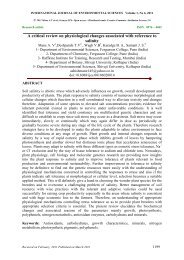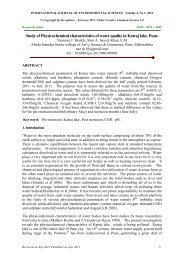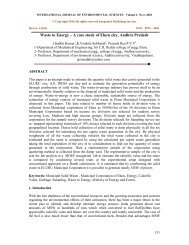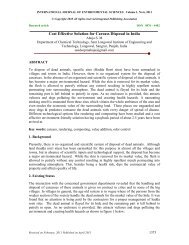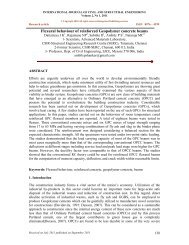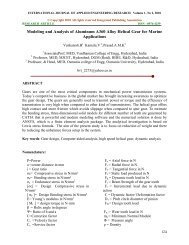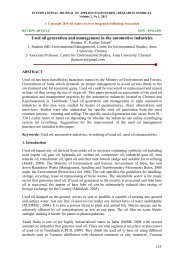Design studies of a square ring shaped force sensor - Integrated ...
Design studies of a square ring shaped force sensor - Integrated ...
Design studies of a square ring shaped force sensor - Integrated ...
Create successful ePaper yourself
Turn your PDF publications into a flip-book with our unique Google optimized e-Paper software.
INTERNATIONAL JOURNAL OF APPLIED ENGINEERING RESEARCH, DINDIGUL<br />
Volume 1, No 4, 2011<br />
© Copyright 2010 All rights reserved <strong>Integrated</strong> Publishing Association<br />
RESEARCH ARTICLE ISSN 09764259<br />
<strong>Design</strong> <strong>studies</strong> <strong>of</strong> a <strong>square</strong> <strong>ring</strong> <strong>shaped</strong> <strong>force</strong> <strong>sensor</strong><br />
Madhuban Prasad 1 , Nabi Hasan 2 , Anil Kumar 3 , Harish Kumar 3<br />
1Department <strong>of</strong> Mechanical Enginee<strong>ring</strong>, Sundeerdeep College <strong>of</strong> Enginee<strong>ring</strong> and<br />
Technology, Ghaziabad, Uttar Pradesh, India<br />
2Department <strong>of</strong> Mechanical Enginee<strong>ring</strong>, Al Falah School <strong>of</strong> Enginee<strong>ring</strong> and Technology,<br />
Faridabad, Haryana, India<br />
3 National Physical Laboratory (Council <strong>of</strong> Scientific & Industrial Research), New Delhi.<br />
kradprasadm@gmail.com<br />
ABSTRACT<br />
The present study aims to study the <strong>square</strong> <strong>ring</strong> <strong>shaped</strong> <strong>force</strong> <strong>sensor</strong> and role <strong>of</strong> finite element<br />
analysis in designing the <strong>force</strong> <strong>sensor</strong>. Square <strong>ring</strong> <strong>shaped</strong> <strong>force</strong> <strong>sensor</strong> has been derived from<br />
the circular <strong>ring</strong> <strong>shaped</strong> <strong>force</strong> <strong>sensor</strong>, commonly used. A <strong>square</strong> <strong>ring</strong> <strong>shaped</strong> <strong>force</strong> <strong>sensor</strong>s has<br />
been designed and its three dimensional model has been developed using s<strong>of</strong>tware ABAQUS<br />
6.7.2. The <strong>force</strong> <strong>sensor</strong> has been studied using finite element analysis and the findings are<br />
presented in form <strong>of</strong> stress – strain and deflection plots. The study further attempts to suggest<br />
modifications in the analytical expressions available for finding stress – strain and deflection<br />
in <strong>ring</strong> <strong>shaped</strong> <strong>force</strong> <strong>sensor</strong> to use them in case <strong>of</strong> <strong>square</strong> <strong>ring</strong> <strong>shaped</strong> <strong>force</strong> <strong>sensor</strong>s.<br />
Key words: Force <strong>sensor</strong>, finite element analysis<br />
Symbols<br />
b<br />
width <strong>of</strong> the cross section <strong>of</strong> <strong>ring</strong> (mm)<br />
t<br />
thickness <strong>of</strong> cross section <strong>of</strong> <strong>ring</strong> (mm)<br />
R i<br />
inner radius <strong>of</strong> <strong>ring</strong> (mm)<br />
R o<br />
outer radius <strong>of</strong> <strong>ring</strong> (mm)<br />
R<br />
mean radius (mm)<br />
F<br />
applied <strong>force</strong> (N)<br />
E young’s modulus <strong>of</strong> elasticity (N/m 2 )<br />
U<br />
strain energy (J)<br />
M A moment due to <strong>force</strong> at A (Nm)<br />
M<br />
moment due to <strong>force</strong> at any position (Nm)<br />
q<br />
angle <strong>of</strong> segment <strong>of</strong> <strong>ring</strong> (radian)<br />
d<br />
deflection <strong>of</strong> the <strong>ring</strong> (mm)<br />
σ stress, N/m 2<br />
ε<br />
strain<br />
1. Introduction<br />
Force, being a vital parameter having applications in various functional areas has been<br />
measured by a variety <strong>of</strong> <strong>sensor</strong>s <strong>of</strong> capacities ranging from few newtons to mega newtons.<br />
The <strong>force</strong> <strong>sensor</strong>s may be <strong>ring</strong> <strong>shaped</strong> <strong>force</strong> <strong>sensor</strong>s, strain gauged load cells, tuning fork type<br />
<strong>sensor</strong>s depending upon their suitability for particular applications. Ring <strong>shaped</strong> <strong>force</strong> <strong>sensor</strong>s,<br />
commonly used due to ease in manufactu<strong>ring</strong>, have been always a centre <strong>of</strong> research for the<br />
<strong>force</strong> <strong>sensor</strong>s for many decades. A number <strong>of</strong> researchers have worked in past and have<br />
suggested suitable modifications like octagonal, extended octagonal <strong>ring</strong> <strong>shaped</strong> <strong>force</strong> <strong>sensor</strong>s<br />
727
INTERNATIONAL JOURNAL OF APPLIED ENGINEERING RESEARCH, DINDIGUL<br />
Volume 1, No 4, 2011<br />
© Copyright 2010 All rights reserved <strong>Integrated</strong> Publishing Association<br />
RESEARCH ARTICLE ISSN 09764259<br />
etc (Chen.B et.al,2007). Various expressions have been developed for stress / strain and axial<br />
deflection for the modified shapes suggested so far. But, other modifications have not been<br />
suggested and studied so far like hexagonal <strong>ring</strong> shape or <strong>square</strong> <strong>ring</strong> shape. Besides it, no<br />
past observations are found about the <strong>studies</strong> related to <strong>square</strong> <strong>ring</strong> <strong>shaped</strong> <strong>force</strong> <strong>sensor</strong>s.<br />
Hence, the present paper attempts to study a <strong>square</strong> <strong>ring</strong> <strong>shaped</strong> <strong>force</strong> <strong>sensor</strong> as a<br />
modifications <strong>of</strong> the <strong>ring</strong> <strong>shaped</strong> <strong>force</strong> <strong>sensor</strong>s analytically and suggests suitable<br />
modifications in the analytically derived expressions for stress / strain and deflection under<br />
action <strong>of</strong> external <strong>force</strong>s subjected to a <strong>ring</strong> <strong>shaped</strong> <strong>force</strong> <strong>sensor</strong> with the help <strong>of</strong> finite<br />
element analysis. The s<strong>of</strong>tware used for finite element analysis is ABAQUS 7.2 standard<br />
student edition.<br />
2. Analytical Study<br />
Ring <strong>shaped</strong> <strong>force</strong> <strong>sensor</strong>s have been studied by various researchers and the analytically<br />
derived expressions for stress / strain and deflection <strong>of</strong> the <strong>force</strong> <strong>sensor</strong> are well know, though<br />
few deviations has been observed by experimental <strong>studies</strong>. The <strong>ring</strong> <strong>shaped</strong> <strong>force</strong> <strong>sensor</strong>s and<br />
the expressions used for stress / strain and deflection have been discussed else where<br />
(Harishkumar Et.al, 2011). The <strong>ring</strong> <strong>shaped</strong> <strong>force</strong> <strong>sensor</strong> has been analyzed under action <strong>of</strong><br />
axial <strong>force</strong>s (Figure 1) and has been modeled as a <strong>ring</strong>. Taking the advantage <strong>of</strong> symmetry, a<br />
quarter may be selected for the analytical study. The free body diagram suggests that the<br />
moment M is statistically indeterminate, the strain energy U for this quadrant <strong>of</strong> the <strong>ring</strong> is<br />
due only to the bending moment M in the <strong>ring</strong>. According the castigliano’s theorem<br />
(Kumar,2010)<br />
F<br />
R i<br />
R 0<br />
F/2<br />
θ<br />
F<br />
Figure 1: Ring Shaped Force Transducer – Idealizing as a Ring<br />
U<br />
M<br />
= 0<br />
(1)<br />
728
INTERNATIONAL JOURNAL OF APPLIED ENGINEERING RESEARCH, DINDIGUL<br />
Volume 1, No 4, 2011<br />
© Copyright 2010 All rights reserved <strong>Integrated</strong> Publishing Association<br />
RESEARCH ARTICLE ISSN 09764259<br />
( M ds )<br />
U = ò (2)<br />
2 EI<br />
Where, θ defines any section <strong>of</strong> the beam and strain energy.<br />
Hence,<br />
2<br />
( M Rd q )<br />
U = ò (3)<br />
2 EI<br />
And, the radial deflection at B is calculated from the Castigliano’s theorem as,<br />
2<br />
U<br />
d i = ,.....( i = 1, 2,... n )<br />
(4)<br />
F<br />
For any section, the bending moment may be find as,<br />
FR (1 - cos q )<br />
M = M x - (5)<br />
2<br />
Mx<br />
1 1<br />
= FR ( - )<br />
(6)<br />
2 p<br />
FR 2<br />
M x = ( )(1 - )<br />
(7)<br />
2 p<br />
3<br />
æ FR ö æ p 2 ö<br />
d = ç ÷ ç – ÷<br />
(8)<br />
è EI ø è 4 p ø<br />
Net deflection for a <strong>ring</strong> cross section is as follow,<br />
3<br />
0.149PR<br />
d = (9)<br />
EI<br />
6M<br />
Stress, s = (10)<br />
2<br />
bt<br />
6M<br />
Strain, e = (11)<br />
2<br />
Ebt<br />
For, a 20 kN <strong>force</strong> <strong>sensor</strong> made <strong>of</strong> material EN 24 and modulus <strong>of</strong> elasticity 210 GPa, having<br />
inner radii 86 mm, outer radii 96 mm and width 45mm, the following particulars are found<br />
using above expressions.<br />
Deflection = 2.85 mm<br />
Stress = 441 MPa<br />
Strain = 2.1 x 10 3<br />
The <strong>force</strong> <strong>sensor</strong> has been modified as a <strong>square</strong> <strong>ring</strong> <strong>shaped</strong> <strong>force</strong> <strong>sensor</strong> taking the<br />
dimensions given above and studied using finite element analysis a tool.<br />
729
INTERNATIONAL JOURNAL OF APPLIED ENGINEERING RESEARCH, DINDIGUL<br />
Volume 1, No 4, 2011<br />
© Copyright 2010 All rights reserved <strong>Integrated</strong> Publishing Association<br />
RESEARCH ARTICLE ISSN 09764259<br />
3. Finite Element Model and Analysis<br />
Similar finite element analysis has been done for <strong>ring</strong> <strong>shaped</strong> <strong>force</strong> <strong>sensor</strong> earlier by various<br />
researchers. The s<strong>of</strong>tware ABAQUS standard student edition 6.7.2 has been used for<br />
modeling and analysis <strong>of</strong> the <strong>force</strong> <strong>sensor</strong>s developed. A three dimensional quarter <strong>of</strong> the<br />
idealized <strong>square</strong> <strong>ring</strong> has been designed and suitable boundary conditions have been defined<br />
for finite element analysis. A three dimensional solid continuum 8 node element with reduced<br />
integration is considered and the analysis is <strong>of</strong> linear type. The material is <strong>of</strong> isotropic nature.<br />
The axial <strong>force</strong> is applied in compression mode as an indication <strong>of</strong> methodology using<br />
ABAQUS 6.7.2 s<strong>of</strong>tware for studying stress – strain and axial deflection pattern. Suitable<br />
procedure for finite element analysis <strong>of</strong> the quarter <strong>of</strong> the <strong>ring</strong> has been adopted and the stress,<br />
strain and axial deflection patterns have been plotted. The findings <strong>of</strong> the finite element<br />
analysis may be summarized in form <strong>of</strong> stress, strain and axial deflection patterns (Fig 24).<br />
4. Results & Discussions<br />
Figure 2 expresses the stress distribution <strong>of</strong> the quarter <strong>of</strong> <strong>ring</strong> when it is under axial <strong>force</strong> in<br />
tension mode. Maximum stress occurs at the upper top point where the <strong>force</strong> is applied. From<br />
the point <strong>of</strong> application <strong>of</strong> axial <strong>force</strong>, along the periphery, the stress tends to decrease.<br />
Figure 2: Stress Distribution <strong>of</strong> a Quarter Square Ring<br />
The maximum value <strong>of</strong> stress is found to be 118.7 MPa in comparison to 449.1 MPa for <strong>ring</strong><br />
<strong>shaped</strong> <strong>force</strong> <strong>sensor</strong> <strong>of</strong> similar dimensions and capacity (maximum values <strong>of</strong> stresses have<br />
730
INTERNATIONAL JOURNAL OF APPLIED ENGINEERING RESEARCH, DINDIGUL<br />
Volume 1, No 4, 2011<br />
© Copyright 2010 All rights reserved <strong>Integrated</strong> Publishing Association<br />
RESEARCH ARTICLE ISSN 09764259<br />
been rejected due to Saint Venant’s theory). Figure 3 discusses the strain distribution for<br />
quarter <strong>of</strong> <strong>ring</strong> under action <strong>of</strong> axial <strong>force</strong>. The strain distribution follows the similar pattern<br />
to the stress distribution. The strain is 0.51 x 10 3 in comparison to 2.02 x 10 3 for <strong>ring</strong><br />
<strong>shaped</strong> <strong>force</strong> <strong>sensor</strong> <strong>of</strong> similar dimensions and capacity (maximum values <strong>of</strong> strains have<br />
been rejected due to Saint Venant’s theory).<br />
Figure 3: Strain Distribution <strong>of</strong> a Quarter Square Ring<br />
Figure 4 explains the axial deflection <strong>of</strong> the quarter <strong>of</strong> the <strong>ring</strong> when it is an external <strong>force</strong> is<br />
applied. The axial deflection is highest at the free end, but it tends to decrease along the<br />
periphery <strong>of</strong> the quarter and is almost negligible at the other end <strong>of</strong> the quarter. One end <strong>of</strong><br />
the quarter <strong>of</strong> the <strong>ring</strong> is considered fixed and no rotation has been permitted, hence, the<br />
axial deflection has been almost negligible there. It is 0.927 mm in comparison to 1.749 mm<br />
for <strong>ring</strong> <strong>shaped</strong> <strong>force</strong> <strong>sensor</strong> <strong>of</strong> similar dimensions and capacity (maximum values <strong>of</strong><br />
deflections have been rejected due to Saint Venant’s theory).<br />
731
INTERNATIONAL JOURNAL OF APPLIED ENGINEERING RESEARCH, DINDIGUL<br />
Volume 1, No 4, 2011<br />
© Copyright 2010 All rights reserved <strong>Integrated</strong> Publishing Association<br />
RESEARCH ARTICLE ISSN 09764259<br />
Figure 4: Deflection Pattern <strong>of</strong> a Quarter <strong>of</strong> Square Ring<br />
It has been found that the stress and strain are about 1/4 th <strong>of</strong> the stress – strain for the <strong>ring</strong><br />
<strong>shaped</strong> <strong>force</strong> <strong>sensor</strong>s <strong>of</strong> similar capacities. Beside it, the deflection is about half <strong>of</strong> the<br />
deflection for similar <strong>ring</strong> <strong>shaped</strong> <strong>force</strong> <strong>sensor</strong> [9].<br />
The analytical expressions may be suggested as follow for the <strong>square</strong> <strong>ring</strong> <strong>shaped</strong> <strong>force</strong><br />
<strong>sensor</strong>.<br />
3<br />
0.075PR<br />
d =<br />
EI<br />
(12)<br />
1.5M<br />
s =<br />
2<br />
bt<br />
(13)<br />
1.5M<br />
e =<br />
2<br />
Ebt<br />
(14)<br />
5. Conclusions<br />
The finite element analysis <strong>of</strong> the <strong>square</strong> <strong>ring</strong> <strong>shaped</strong> <strong>force</strong> <strong>sensor</strong> reveals information about<br />
stress / strain distribution and axial deflection pattern <strong>of</strong> <strong>force</strong> <strong>sensor</strong> under action <strong>of</strong> axial<br />
<strong>force</strong>s. The finite element analysis has been used for obtaining vital informations related to<br />
stress – strain and has been used here to modify the analytical expressions available for stress<br />
– strain and deflection for a <strong>square</strong> <strong>ring</strong> <strong>shaped</strong> <strong>force</strong> <strong>sensor</strong>. Further, the stress / strain<br />
732
INTERNATIONAL JOURNAL OF APPLIED ENGINEERING RESEARCH, DINDIGUL<br />
Volume 1, No 4, 2011<br />
© Copyright 2010 All rights reserved <strong>Integrated</strong> Publishing Association<br />
RESEARCH ARTICLE ISSN 09764259<br />
distribution may be useful for developing strain gauged <strong>sensor</strong> by locating suitably the strain<br />
gauges that may be implanted to the <strong>sensor</strong>. The use <strong>of</strong> finite element analysis further may be<br />
extended to study the effect <strong>of</strong> nominal quantities over the <strong>force</strong> <strong>sensor</strong>.<br />
6. References<br />
1. B Chen, X Wu, X Peng, 2007, Finite Element Analysis <strong>of</strong> Ring Strain Sensor, Sensor<br />
Actuat A Phys, 139, pp 6669.<br />
2. Harish Kumar, Chitra Sharma, Anil Kumar, 2011, <strong>Design</strong> <strong>studies</strong> <strong>of</strong> Ring Shaped<br />
Force Transducer, International Journal <strong>of</strong> Enginee<strong>ring</strong> Science and Technology,<br />
3(2), pp 15361541.<br />
3. Harish Kumar, S K Jain, Evaluation <strong>of</strong> Axial Sensitivity Evaluation <strong>of</strong> Circular<br />
Shaped Force Proving Ring using Finite Element Method (FEM), 7 th International<br />
Conference on Advances in Metrology (Admet 2009), National Physical Laboratory,<br />
New Delhi, pp 118119.<br />
4. Kumar H, Sharma C, Gupta S, Deflection Studies <strong>of</strong> a Force Transducer, 10 th<br />
International Conference on Research & Development in Mechanical Industry<br />
(RaDMI 2010), Donji Milanovac, Serbia, pp 300303.<br />
5. Josue Njock Libii, 2006, <strong>Design</strong>, <strong>Design</strong> Analysis and Testing <strong>of</strong> a Force Sensor for<br />
Use in Teaching and Research, World Transaction on Enginee<strong>ring</strong> and Technology<br />
Education, 5(1) , pp 175178.<br />
6. M A Rehman, S Rehman, 2007, A Computer Program for <strong>Design</strong>ing Circular Proving<br />
Rings <strong>of</strong> Uniform Strength, Journal <strong>of</strong> the Institution <strong>of</strong> Engineers (India) Mechanical<br />
Enginee<strong>ring</strong> Division, 88, pp 37.<br />
7. M J O’Dogherty, 1996, The <strong>Design</strong> <strong>of</strong> Octagonal Ring Dynamometers, J. agric.<br />
Engng Res., 63, pp 918.<br />
8. Sedat Karabay, 2007, Analysis <strong>of</strong> Drill Dynamometer with Octagonal Ring Type<br />
Transducers for Monito<strong>ring</strong> <strong>of</strong> Cutting Forces in Drilling and Allied Process, Mater<br />
Des, 28, pp. 673685.<br />
9. Sudhir Kumar, Wakkar Ali, Anil Kumar, Harish Kumar, Deflection Studies <strong>of</strong> a Ring<br />
Shaped Force Transducer: A Review, 2011, International Journal <strong>of</strong> Enginee<strong>ring</strong><br />
Science and Technology, 3(2), pp 13301333.<br />
733



